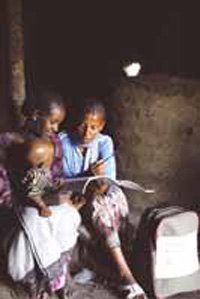1.6.1 Methods for mobilising community action
Box 1.1 summarises the main methods for community mobilisation. Our coverage is brief here because you have already met all the methods in the Module on Health Education, Advocacy and Community Mobilisation.
Box 1.1 Methods for community mobilisation
Posters: Well-designed posters, placed and located in the right place can facilitate messages to keep reminding people about the issue of concern.
Letter writing: This is one way of delivering health messages to literate members of the community. It gives the exact message and can be kept for future reference.
Illustrated leaflets: Pictures are a good way of getting the message to people whose level of literacy is insufficient to understand letters (Figure 1.3).
Home visiting: This is the best way of mobilising the community, because you can be sure that the message has been delivered.

Community mobilisation is based on a high level of community participation, which occurs when community members taking part in identification of problems and needs, and then plan, implement, monitor and evaluate community activities to solve the identified problem.
The fundamental principle that you always need to remember is that you are not there to ‘enforce’ community participation. Your role is to explore, to learn from community wisdom, and to educate and persuade community members to bring about the necessary changes — in this case to improve postnatal outcomes. The final word and the final decision always belong to the community.
1.6 Community mobilisation for postnatal care
